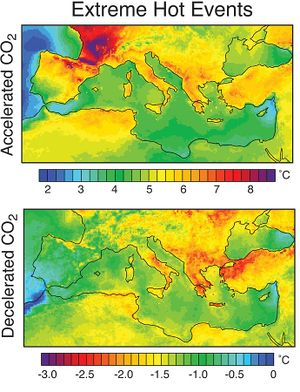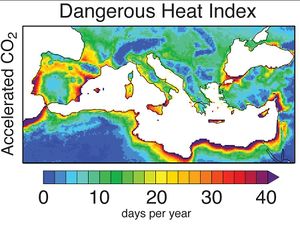Mediterranean Sea and Region, including Adriatic Sea
The Mediterranean Sea is a largely enclosed sea, with high temperature and salinity, and decreasing freshwater due to dams and river diversions. Under the changing climate regime, sea surface temperatures and salinity will increase. Biodiversity, conservation, water quality, quantity and seasonal flows are significantly affected. The negative impacts of pollution and nutrients may increase. Depending on the local characteristics, erosion, sediment deposition, drought, desertification and flooding may intensify or shift. Coastal and beach tourism is also an important source of income in the Mediterranean and south Atlantic regions, and the ongoing economic viability of these regions and local communities may depend on the maintenance of the coastal and marine ecosystems that tourism activity and other activities such as fisheries depend upon.
Contents
Mediterranean Sea and Region
All these uses must be consider in the context of climate change. For examples, for the Mediterranean, complex interactions between overfishing and climate change could facilitate ecosystem shifts. An example is the presence of algal blooms and jellyfish in Mediterranean due to combination of higher water temperatures, overfishing and nutrient influxes. Algal blooms are boosted by nitrate and phosphate influxes from farming and human wastes, and jellyfish benefit from the reduction of natural predators such as loggerhead turtles and the bluefin tuna, which have been drastically reduced by overfishing. Once jellyfish are predominant, it can difficult for juvenile fish populations to re-establish the prior predator-prey relationship. Reduced river flows during hotter summers might also lead to increased numbers of jellyfish near the shore, as freshwater currents no longer keep the jellyfish offshore. The predominance of jellyfish and algal blooms in coastal waters and adjacent to beaches also reduces the attractiveness of tourism for those beaches.
Enclosed shallow seas like the Mediterranean Sea, as well as the Baltic Sea and Black Sea are vulnerable to warming and other climate changes. On a longer term basis, ecosystems shifts such as jellyfish and algae could also be perceived as an indication that the Mediterranean Sea and region is under stress, and that the sea is becoming "tropicalised". The Mediterranean climate, typified by cool wet winters and dry hot summers, may be shifting with related impacts on terrestrial, coastal and marine ecosystems and biodiversity, and the economies and communities they support.
In complex ways, climate change affects the ecological or carrying capacity of these natural ecosystems. In order to allow these coastal and marine ecosystems to adapt to the climate changes that will occur, human stresses, including those caused by all these developments, may need to be reduced. Among other matters, this requires an integrative and ongoing ecosystem based approach to the planning of these developments. Separate from these economic and conservation needs, coastal and marine ecosystems meet many needs for local communities such as food, transport, recreation, as well as providing cultural and historical links.
Water uses and alterations in quality and quantity
Water uses, and alterations in water quality and quantity, may be complemented and aggravated by seasonal shifts and changes in temperature and precipitation due to climate change. Many water uses in coastal communities in the Mediterranean are unsustainable. These water uses may reduce river flows and drain existing ground water aquifers. Climate change may further reduce these river flows, and impede the replenishment of these aquifers, even if more sustainable withdrawals are attempted. Additionally, saltwater intrusion of these aquifers and estuaries will become an increasing risk as the sea level rises. This risk of saltwater intrusion is particularly great for groundwater aquifers on islands and coasts where aquifers are already depleted.
Availability of water is already an issue in some destinations in the Mediterranean. Water is already imported to some islands, while desalination is a water source for some of the Canaries Islands, located in the south Atlantic off the coast of western Africa. In parts of the Algarve region of Portugal, unsustainable water uses and varying seasonal and annual precipitation are combined with extensive coastal developments and roads, which vary the drainage and water retention patterns. In the future, climate change may result in higher summer temperatures and less and changing precipitation patterns, so existing water shortages may increase.
Alterations in water quality due to pollution, nutrient flows, and the disposal of storm water and sewage and other urban wastes (particularly in estuaries, bays and shallow enclosed seas) may be increased by climate change and changing sea surface temperature, stratification, precipitation, and circulatory patterns. For example, much of the sewage and storm water from the larger settlements located on the Mediterranean Sea flow untreated or minimally treated into the sea. Additionally, nutrients and chemicals from agricultural production also enter rivers that enter the sea. For Adriatic Sea, this combination of inputs results in a eutrophic sea during parts of the year. Climate change, including increasing sea temperatures and stratification may increase the impact and extent of this eutrophication in the Adriatic and Mediterranean Seas, as well as other enclosed seas like the Baltic and Black Seas.
Drought, desertification and flooding
Climate change has resulted in increased forecasts of higher temperatures, as well as drought and desertification in the Mediterranean and south Atlantic regions. In the future, this could discourage tourism in the summer months, moving tourism more to other seasons or adjacent months. These regions are also vulnerable to changing seasonal and annual precipitation patterns, including more intense rainfall events and increased flooding. The projected temperature increases resulting from climate change are quite striking, and could be disproportionately felt in the summer season.
Sustainable water uses will be relevant as temperatures increase. Greater temperatures, as well as greater energy efficiencies and carbon reductions, will need to be considered for the future design of the built environment (see Fig. 1). Energy uses may have to increase in the future in order to provide cooling during the hotter summer period. Unless this energy is locally sourced or inexpensive, the economic viability of these developments and communities could be affected. Sustainable developments could include energy efficiency and to generate and use renewable or low carbon energy sources.
Sea level rise, storm events and erosion

Coasts, deltas, estuaries, lagoons, enclosed seas, and arctic coasts are vulnerable coastal systems that are affected by sea level rise, storm events and erosion. Some European examples are the enclosed seas of the Adriatic, Mediterranean, Baltic and Black Seas. These vulnerable coastal ecosystems can be used as indicators of climate change, and to further understand approaches to and effectiveness of adaptation and mitigation strategies for climate change. For the coasts, infrastructure and development, sea level rise will continue as an issue well into the future. It is interesting to note the shared and high vulnerability of lagoons, estuaries, deltas and arctic coasts to sea level rise, as well as storm surges and other extreme weather events.
Two other examples are the Venice lagoon and the central coastal region of Portugal. The Venice lagoon, the infrastructure and the communities are very vulnerable to sea level rise and storm events, with natural and human-induced vulnerability increased by climate changes. Venice is not only threatened by high tides, but is sinking through subsidence, at the same time as the Adriatic Sea is rising. The surrounding marshes, which used to break the waves coming into the city, have gradually disappeared, and industrial development on the mainland has added to the increased subsidence and pollution.
Venice and the Venetian lagoon, of which the city is one integral part, are vulnerable to both extreme weather events and "normal" flooding, which now occurs up to 10 times in one year. Due to the subsidence of the lagoon (human induced and geological), as well as overall subsidence in the Adriatic Sea, Venice and the Venetian lagoon are also vulnerable to even a 10 centimetre increase in sea level, and will be dramatically affected by a large increase in sea level. The Moses project, which is comprised of 9 barriers, was approved in 2003, is now estimated to cost more than 5 billion euros, and is designed to rise from the seabed to block the inlets of the Venice lagoon from the Adriatic Sea when high tides are forecast. Given the sensitivity of Venice and the overall lagoon to climate change, it could also be considered as a model and indicator for global impacts of climate change for lagoons and coasts.
Coastal erosion is affected by extreme weather events, which can have major and catastrophic events on certain coasts. Some changes in sediment deposit may be amplified by climate change, such as a loss of sediment in storm events. In addition to extreme weather events, coasts may be eroded due to changes in sediment deposit, removal due to the construction of offshore structures and alterations of rivers through dams and diversions, resulting in changes in water flows and sediment deposition. Changes in sediment deposits results from changes in water flow due to a number a reasons. These include: the construction of dams on upstream rivers and watersheds, the removal of natural coastal habitats (i.e. wetlands), the construction of coastal structures and defences and the construction of offshore structures.
The Atlantic coast of central Portugal and settlements such as Aveiro and Figueira da Foz are very vulnerable to combination of climate changes and coastal erosion, storm events, and changes in sediment deposit due to coastal dikes, groynes and upstream dams. Due to its depth, and absence of replenishing sediment deposits, the Venice lagoon can be impacted by shallow wave actions.
Please note that others may also have edited the contents of this article.
|
